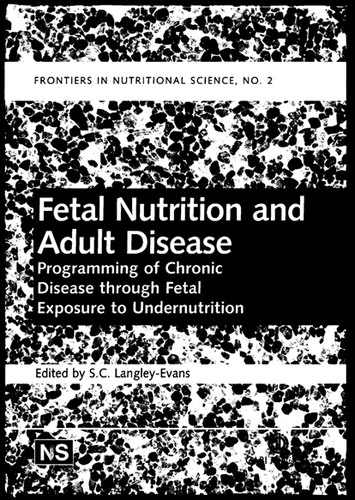SC Langley-Evans, ed. Wallingford: CABI; 2004. 448 pp.
ISBN 0-85199-821-6. US $140.
The developmental origin of adult diseases is a growing field of interest, and involves studies on how the health of the adult is influenced by processes from the preconceptional to the early postnatal period. Such influences are called programming, i.e. a specific stimulus or insult during this critical period may lead to developmental adaptations that permanently change structure, physiology and metabolism, and may lead to pathological conditions later in life. Interest in the field began in the 1960s with the studies of Widdowson and Chance, but Barker's observations in the late 1980s are usually referred to as the starting point for more global interest in the field. Barker studied middle-aged men with cardiovascular disease and found that they had low birth weight and were born in areas with high infant mortality and low socioeconomic status, indicating that nutritional factors during pregnancy and early life were of importance for the later development of disease; this is usually referred to as Barker's hypothesis. Lucas later gave the definition of programming as above, and has contributed longitudinal studies in the neonatal period to support the hypothesis. Until now, only two world congresses have focused exclusively on the topic, but they gathered people from all over the world and had a very successful and rich programme.
The book reviewed here gives a comprehensive statement of the present knowledge in the field. It is organized in three parts; first, on the basic principles of foetal programming; secondly, on animal experiments to support human epidemiological studies; and thirdly, on the biological basis of foetal--placental interaction, endocrinology and gene interaction. The first chapter is a brief introduction to the field. Nutrition is then generally discussed in one chapter, but is also focused on in different chapters in relation to obesity, diabetes, renal disease and general undernutrition (mainly as protein deficiency); although this means that there is some duplicate information, this does not matter for the reader who may just focus on one field and use the book for reference.
There are some omissions. The chapter on foetal hypoxaemia does not give evidence for this as a cause of programming of adult disease. In different models to explain the development of hypertension, the influence of essential fatty acids, as reported from Australia, is not mentioned. In general, fatty acids, as strong modulators of gene expression, are not included in the discussions in the book, except in the chapter extensively reviewing the knowledge about programming in relation to atopic disease. The aspects of fatty acids as modulators are not touched on in the two excellent chapters of programming in relation to adiposity in adult life, despite a rich literature about the impact of fatty acids on enzymes implemented in lipolytic and glucolytic systems. This is probably related to the fact that, as in many other papers, protein-calorie undernutrition is not acknowledged to include essential fatty acid deficiency, which it certainly does. Therefore, reference to this kind of malnutrition focuses exclusively on protein, which hampers the discussion and is also evident in the otherwise comprehensive chapter on immune function.
Although popularly known, it is only recently that concerns have been raised about the importance of the mother's condition at time of conception. It is meritorious that one chapter focuses on this subject, although it is very speculative, concentrating on DNA methylation as one way to influence gene expression in foetal programming. Lastly, the chapters about endocrinology and the hypothalamic--pituitary--adrenal axis show that many questions remain to be answered in order to understand the mechanisms behind programming.
Dr Simon C Langley-Evans, the editor, is very active in the field and has written three of the 16 chapters, with another three coming from his university. This is both a strength and a weakness of the book, because it concentrates the interest in the field where he is an outstanding expert. However, for those who want to be informed in the field, this is a comprehensive introduction, which should stimulate both further research and discussion.
